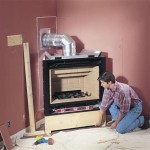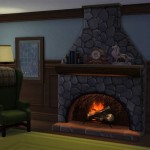Vented Versus Ventless Gas Fireplace Inserts: A Detailed Comparison
Gas fireplace inserts represent a popular and efficient method of converting existing wood-burning fireplaces into user-friendly and cleaner heating appliances. These inserts are designed to fit directly into the existing fireplace opening, offering the ambiance of a traditional fire without the associated hassle and mess. When selecting a gas fireplace insert, one key decision involves choosing between a vented or ventless model. Both options offer distinct advantages and disadvantages, making the optimal choice dependent on individual needs, preferences, and existing home infrastructure.
This article will delve into a comprehensive comparison of vented and ventless gas fireplace inserts, exploring their functionalities, benefits, drawbacks, safety considerations, and installation requirements. By understanding the nuances of each type, homeowners can make an informed decision that aligns with their heating needs and lifestyle.
Understanding Vented Gas Fireplace Inserts
Vented gas fireplace inserts operate by burning natural gas or propane and expelling the combustion byproducts, including carbon monoxide, through a dedicated venting system. This system typically utilizes the existing chimney or a new vent pipe specifically installed for the insert. The presence of a vent is crucial for ensuring safe and efficient operation.
The primary function of the vent is to remove harmful gases and moisture produced during combustion. This prevents the buildup of these byproducts within the home, mitigating the risk of carbon monoxide poisoning and maintaining indoor air quality. Vented inserts draw air from the room for combustion and exhaust the resulting gases outside, creating a continuous airflow.
Vented gas fireplace inserts offer a more realistic flame appearance compared to ventless models. The flame is brighter, taller, and more dynamic, closely resembling a traditional wood-burning fire. This aesthetic appeal is a significant factor for homeowners who prioritize the visual aspect of a fireplace.
The heating efficiency of vented gas fireplace inserts is generally lower than ventless models. A significant portion of the heat produced by the fire is lost through the venting system. While they still provide supplemental heating, their primary purpose is often aesthetic rather than solely for warming the surrounding space.
Installation of a vented gas fireplace insert involves connecting the unit to a gas line and ensuring proper venting through the chimney or a dedicated vent pipe. Professional installation is strongly recommended to ensure safe and compliant operation. The existing chimney must be inspected and potentially relined to meet current safety standards and prevent potential issues such as backdrafting.
Exploring Ventless Gas Fireplace Inserts
Ventless gas fireplace inserts, also known as vent-free inserts, are designed to operate without the need for an external venting system. They burn natural gas or propane with a high level of efficiency, converting nearly all the fuel into heat. These inserts incorporate sophisticated oxygen depletion sensors (ODS) to ensure safe operation.
The ODS system continuously monitors the oxygen levels in the room. If the oxygen level drops to a predetermined threshold, indicating a potential buildup of carbon monoxide, the ODS automatically shuts off the gas supply to the insert. This safety feature is paramount in preventing carbon monoxide poisoning. Regular cleaning and maintenance of the ODS system are crucial for its continued effectiveness.
Ventless gas fireplace inserts offer significantly higher heating efficiency than vented models. Since all the heat is retained within the room, they can effectively warm a designated area using less fuel. This makes them a cost-effective option for supplemental heating, particularly in smaller spaces.
The flame appearance of ventless gas fireplace inserts is often less realistic than that of vented models. The flame tends to be smaller, less dynamic, and may appear bluer in color. While manufacturers have made advancements in flame technology, the visual aesthetic generally does not replicate a traditional wood-burning fire as accurately as a vented insert.
Installation of a ventless gas fireplace insert is typically simpler than a vented model, as it does not require connecting to a chimney or vent pipe. However, professional installation is still recommended to ensure proper gas line connection and adherence to local building codes. Adequate room size is essential for ventless inserts to operate safely and efficiently. The insert should be sized appropriately for the square footage of the room to prevent excessive humidity and potential oxygen depletion.
While ventless inserts are equipped with safety features like ODS, they can still contribute to increased humidity levels in the home. The combustion process produces water vapor, which is released into the room. This can be problematic in poorly ventilated homes or areas prone to moisture issues. Regular ventilation is advised when using a ventless gas fireplace insert.
Key Considerations and Comparison Points
When evaluating whether to choose a vented or ventless gas fireplace insert, several key factors must be carefully considered. These include safety, heating efficiency, aesthetic appeal, installation requirements, cost, and maintenance.
Safety Implications
Safety is the paramount consideration when choosing a gas fireplace insert. Vented inserts offer a higher level of inherent safety by expelling combustion byproducts outside the home. This minimizes the risk of carbon monoxide poisoning and reduces concerns related to indoor air quality. However, proper venting and regular chimney maintenance are essential to ensure safe operation. Blocked or damaged vents can pose a significant safety hazard.
Ventless inserts rely heavily on the ODS system to prevent carbon monoxide buildup. While the ODS is an effective safety mechanism, it requires periodic maintenance and cannot entirely eliminate the risk of carbon monoxide exposure. Homeowners should install carbon monoxide detectors and routinely test them to ensure they are functioning correctly. Additionally, regular ventilation is crucial when using a ventless insert to prevent the accumulation of moisture and maintain adequate oxygen levels.
Heating Efficiency and Cost-Effectiveness
Ventless gas fireplace inserts are significantly more efficient than vented models, converting a larger percentage of fuel into usable heat. This can translate into lower heating bills, particularly for supplemental heating applications. The increased efficiency of ventless inserts makes them an attractive option for homeowners seeking to reduce their energy consumption.
While vented inserts are less efficient, advances in technology has improved their heating capacity. Direct vent models, for instance, draw combustion air from outside and exhaust gases directly outside. This creates a sealed system, and improves operation efficiency to some extent.
Aesthetic Appeal and Flame Appearance
Vented gas fireplace inserts typically offer a more realistic and visually appealing flame appearance. The venting system allows for a brighter, taller, and more dynamic flame that closely mimics a traditional wood-burning fire. For homeowners who prioritize the aesthetic aspect of a fireplace, a vented insert is often the preferred choice.
Ventless inserts generally have a less realistic flame appearance. The flame is often smaller, bluer, and less vibrant. While some manufacturers have implemented design improvements to enhance the flame appearance of ventless models, they generally do not match the visual realism of vented inserts.
Installation and Maintenance Requirements
Installation of a vented gas fireplace insert can be more complex and costly than a ventless model. It requires connecting the insert to a gas line and ensuring proper venting through the existing chimney or a dedicated vent pipe. The condition of the chimney must be assessed, and any necessary repairs or relining must be completed before installation. Professional installation is strongly recommended to ensure compliance with local building codes and safety regulations.
Ventless gas fireplace inserts are generally easier and less expensive to install, as they do not require venting. However, professional installation is still advisable to ensure proper gas line connection and adherence to safety standards. Adequate room size and ventilation are crucial considerations when installing a ventless insert.
Both vented and ventless gas fireplace inserts require regular maintenance to ensure safe and efficient operation. Vented inserts require inspection and cleaning of the chimney to prevent blockages and ensure proper venting. Ventless inserts require regular cleaning and maintenance of the ODS system to ensure its continued effectiveness.
The choice between a vented and ventless gas fireplace insert depends on a variety of factors, including individual priorities, budget constraints, and existing home infrastructure. Homeowners must carefully weigh the advantages and disadvantages of each type before making a decision.

Vented Vs Ventless Gas Logs What S The Difference

Vented Or Ventless Gas Fireplace Which One Is Better
:max_bytes(150000):strip_icc()/ventless-gas-fireplaces-4160746-hero-f9d4bdcd9bd446eb84406de306f790ba.jpg?strip=all)
How To Pick Out A Ventless Gas Fireplace

Vented Or Ventless Gas Fireplace Which One Is Better

Vented Vs Ventless Fireplace Explained Finding The Perfect Fit For Y

Which Is Better Vented Or Non Gas Logs

Vented Or Ventless Gas Fireplace Which One Is Better

ᑕ❶ᑐ Ventless Gas Fireplace Insert Disadvantages Of Use
.webp?strip=all)
Vented Or Ventless Gas Fireplace Aire Serv

What Is A Ventless Gas Fireplace Experts In Gaithersbutg Md








